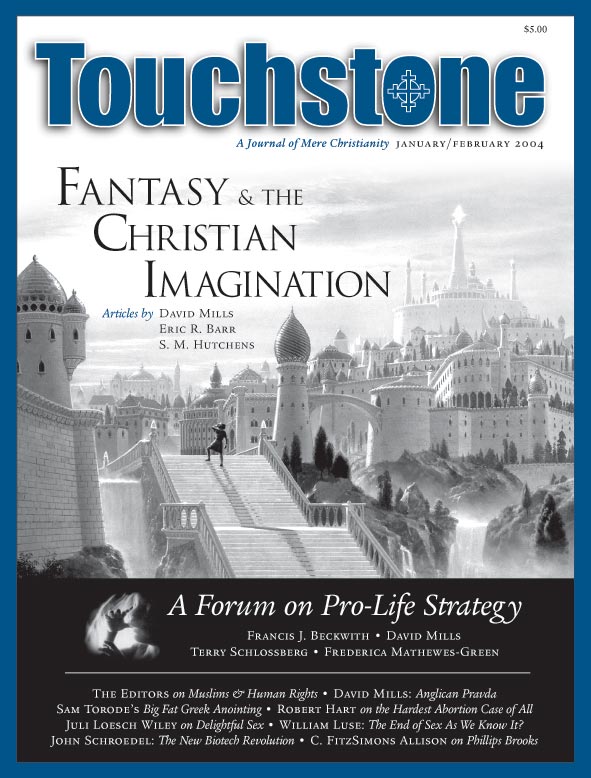My Big Fat Greek Anointing
Sam Torode on Convert Idealism
Evangelical converts to Catholicism and Orthodoxy tend to be a bit, well, evangelical. They often describe their new church homes in a way that makes longtime residents look around, scratch their heads, and ask for a glass of “whatever he’s drinking.”
Having recently been received into the Orthodox Church, I know the temptation. While I’m very grateful for my Baptist upbringing, I’m also aware of its shortcomings. I’m embarrassed to remember how, in high school, I confidently declared that Catholicism was a cult because they added the Apocrypha to the Bible. And I’m embarrassed to remember how, a week after arriving at college, I loaned a book defending the literal, six-day creation of the universe to a girl in my English class. I couldn’t understand why she didn’t seem to appreciate the book—or me.
My simplistic faith couldn’t withstand a liberal arts education. After a time of spiritual drifting in college, I started reading Catholic and Orthodox authors who eventually led me back to the truth of Christ. Still, it took several more years before I finally made the leap to Orthodoxy, along with my wife and our two young boys (who had little say in the matter beyond screaming during their baptisms).
Along the way, an Orthodox priest offered me some good advice: Don’t look for the Perfect Church. “Even if you found such a church, it would cease to be perfect the moment you joined it—because you’re not perfect.”
Still, most of us naturally want our church to be the perfect one. Especially if we’ve just joined it and we’re facing criticism and misunderstanding from family and friends. “If only I can lure a few of them to come in with me,” the convert thinks, “my choice will be justified.” So converts tend to make bold pronouncements: My church is the only one that’s never split—those other churches split off from us. And my church is the only one that has preserved the exact beliefs and practices of the apostles, right down to the direction we make the sign of the cross. And my church has the most beautiful worship, the best government, and the holiest bishops.
Though we knew in our heads that these things weren’t necessarily true, my wife and I still harbored some illusions about the Orthodox Church at the time we became catechumens. Then our priest encouraged us to visit other Orthodox parishes to experience more of the panorama of what’s really out there.
A Prerequisite
During Holy Week, we decided to visit a Greek Orthodox parish for the Wednesday night service of Holy Unction—a healing service, in which the members are anointed with holy oil. We had never attended a Greek service, and since most of the Orthodox in America belong to the Greek archdiocese, it seemed like an important prerequisite. We had tried visiting this same church a half-year earlier, on Thanksgiving weekend. But when we arrived, it was all locked up. No cars, no people, just a sign out front announcing Liturgy at 10:00 a.m.
This time, Bethany made sure she called ahead to confirm that the service was indeed scheduled. We pulled into the church parking lot ten minutes late, as we are prone to do after wrestling our kids into their diapers and clothes. The sight was encouraging—a surprisingly large number of cars for a weekday service.
After prying open the tall, heavy wooden door and peering inside, we were welcomed by a friendly woman. In the foyer, candles were stacked near a cash box. We thought about lighting one, until we saw the price list. Various Orthodox books and artifacts were on display in a glass case. Looking closer, we saw a DVD of My Big Fat Greek Wedding. Even more strangely, we heard a steady stream of loud, cheery voices wafting up from the basement—though the service was well in progress.
When we entered the sanctuary, there were only a handful of elderly folk scattered about. What about all those cars? We tiptoed down the aisle and took a seat in a cramped, hard, wooden pew, the likes of which I hadn’t experienced since my Baptist days. (In some Orthodox parishes there are no pews, and, as converts are fond of reporting, everyone stands for the entire service.)
Once seated, our attention was drawn to the massive iconostasis (a wall covered with icons) behind which lies the altar. Unlike the Byzantine-style icons we were accustomed to, these portraits of Christ and the saints were in the style of sentimental, Victorian Catholic prints.
Off to the side stood the choir: three elderly men chanting from service books entirely in Greek. We weren’t shocked at the lack of English, given what we’d heard about Greek churches, but the lack of participation on the part of the congregation was disconcerting. At the very least, we thought the assembly would interject an occasional “amen” at the end of a prayer. Instead—silence.
A short time after we arrived, two young boys walked in, ambled their way up front, and slunk into a side door in the iconostasis. For the next ten minutes, we could hear them loudly fumbling around, trying to get into their vestments. Candleholders and censors clanged as the priest barked orders. From time to time, he would peek out through a door and scowl at the congregation. His scowl deepened as the night wore on.
About a half-hour into the service, two late-coming families and their children clambered into the pews behind us. Three high-school-age boys wandered forward and attempted to enter the iconostasis. They were turned away at the door. When they arrived back at the pew, one loudly exclaimed to his mother, “He says we’re too late!”
“Too late? Whaddas he mean you’re too late?”
My stomach, already a little tense from the acolytes’ antics, started to churn.
Ding!
The chatter died down as the priest and acolytes paraded out for the Gospel reading. The priest rang a small bell—the kind you use in a store to call the cashier. Ding! For the first time, the congregation rose. At this point, one of the children behind us lost control of a set of colored pencils. They rolled off the pew and cascaded down the slanted floor.
After the Gospel was read (in English—a glimmer of hope), the priest retreated behind his barricade while the acolytes stayed behind to face the congregation. Their listless eyes drifted over the pews. One of them caught the attention of a friend in the back row and tried desperately to mouth a message. He soon gave up, and instead struck up a conversation with his co-conspirator. To amuse themselves, they tried swinging their candleholders upside down. Beads of hot wax splattered on the table and floor.
“Oh look, now they’re goofing off,” grumbled the woman behind us. “Why didn’t he let the older boys in? They weren’t too late!”
My grip on the rim of the pew in front of us tightened.
As the three choir members meandered their way through the service book, the acolytes began to tire. They leaned heavily on their candle staffs. Their eyelids fluttered shut.
Even the woman behind us grew sympathetic. “Awww, look. They’re sooo tired. He’s got to let them sit down!”
The priest emerged for a second Gospel reading. I noticed the acolytes lighting a new votive candle on a candelabra. Two candles now burned, and five were left unlit. It suddenly dawned on me that, though we’d been there an hour, this service was just getting started. The chants and Gospel readings would continue until all the candles were aflame.
The woman behind us decided to loudly and firmly express her resolve that the acolytes must be allowed to sit. “Get up there and tell him to let those boys rest!” she ordered her sheepish young son. He wouldn’t budge. “Well, then go tell Mr. Theodoropolis to tell him.” Still no movement.
I took some comfort in that she seemed to respect the rubrics concerning who is allowed behind the iconostasis.
“Alright,” she decided, “I’m gonna go up there myself and pass him a note.”
As the woman scooted towards the end of her pew, I whispered to my wife, “We’ve got to get out of here—now.” We slipped out into the aisle, trying not to look anyone in the eye, and hit the door running. In our hurry, we left something behind on the pew—our convert idealism.
The Stereotype
Unfortunately, our experience added weight to the “ethnic parish” stereotype. We’ve also heard stories of Orthodox parishes throwing food festivals in the middle of Lent; of one parish that charged visitors admission to its Pascha (Easter) feast; of another where the police had to be called in to break up a heated parish council meeting. Yes, I believe this is the Church of the Apostles—the same apostles who bickered over who was going to get the best seat in heaven.
By the day of our chrismations (our reception into the Orthodox Church), we had a more realistic view of the church into which we were being grafted. We love being Orthodox. We’re grateful and joyful to participate in the sacraments after years of watching from the sidelines.
But when I read books and articles by ebullient converts these days, I take them with a big fat grain of salt.
Sam Torode is a freelance writer and artist who lives in rural Wisconsin with his wife Bethany and their two young sons. A former designer of Touchstone, he and Bethany are the authors of Open Embrace: A Protestant Couple Rethinks Contraception (Eerdmans).
subscription options
Order
Print/Online Subscription

Get six issues (one year) of Touchstone PLUS full online access including pdf downloads for only $39.95. That's only $3.34 per month!
Order
Online Only
Subscription

Get a one-year full-access subscription to the Touchstone online archives for only $19.95. That's only $1.66 per month!
bulk subscriptions
Order Touchstone subscriptions in bulk and save $10 per sub! Each subscription includes 6 issues of Touchstone plus full online access to touchstonemag.com—including archives, videos, and pdf downloads of recent issues for only $29.95 each! Great for churches or study groups.
Transactions will be processed on a secure server.
more on conversion from the online archives
more from the online archives
calling all readers
Please Donate
"There are magazines worth reading but few worth saving . . . Touchstone is just such a magazine."
—Alice von Hildebrand
"Here we do not concede one square millimeter of territory to falsehood, folly, contemporary sentimentality, or fashion. We speak the truth, and let God be our judge. . . . Touchstone is the one committedly Christian conservative journal."
—Anthony Esolen, Touchstone senior editor









